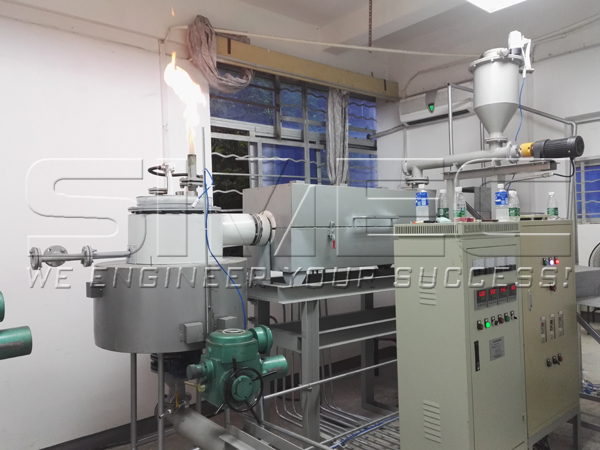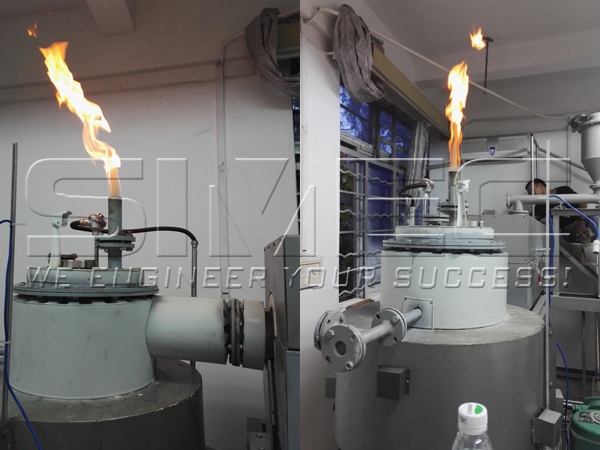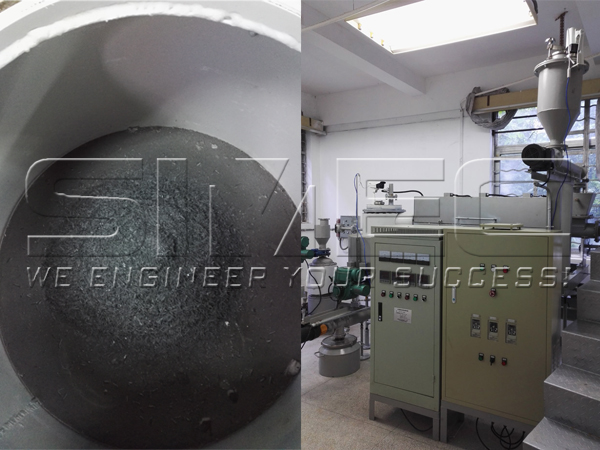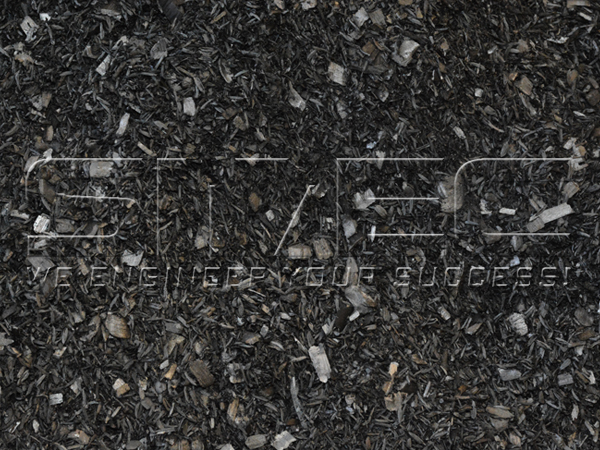Operation Steps of Biomass Torrefaction Experiment
Biomass pyrolysis laboratory apparatus is designed for scientific research on biomass thermal chemical process.
The apparatus can perform biomass thermochemical experiments at set temperature precisely. The sensitive data collecting system records precise experimental datas such as pyrolysis temperature, gas flow volume, pressure and so on. Different types of biomass pyrolysis experiments can be conducted by this apparatus, for example, torrefaction, carbonization, etc.
Compact design of the laboratory apparatus enables the operator to conduct biomass pyrolysis experiments in research office. The simple and accurate operation of the apparatus help the people, who will set up commercial biomass pyrolysis projects, to collect the relevant experimental datas for further analysis and research, then improve commercial operation and enhance commercial benefits.

Biomass Pyrolysis Laboratory Apparatus

Syn-gas Combustion
Realizable Experiments:
※ Torrefaction and other pyrolysis process under different reaction temperature and material flow rate.
※ Collectable experimental samples for further analysis:
Torrefied biomass and biochar sampling.
Syn-gas sampling before purification.
Syn-gas sampling after purification.
Liquid byproduct sampling, such as tar, pyroligneous acid.
※ Syn-gas volume dynamic measurement.
※ Experimental study on combustion of syn-gas before and after purification.


The operation steps described in this article are for the following experimental purposes.
Experimental objective:
※ To get torrefied biomass sample at 275 degrees Celsius, in 30 minutes of reaction time.
※ To calculate mass loss.
Experimental prepare:
※ Biomass raw materials, particle size less than 5mm, moisture ≤ 10%, bulk density 0.15 ton/m3.
※ Fill water in cooling tank.
※ Fill activated carbon or crushed corncob in Filtrator.
※ Set or confirm pressure meter to indicate zero under ordinary pressure.
Experimental steps:
The apparatus can perform biomass thermochemical experiments at set temperature precisely. The sensitive data collecting system records precise experimental datas such as pyrolysis temperature, gas flow volume, pressure and so on. Different types of biomass pyrolysis experiments can be conducted by this apparatus, for example, torrefaction, carbonization, etc.
Compact design of the laboratory apparatus enables the operator to conduct biomass pyrolysis experiments in research office. The simple and accurate operation of the apparatus help the people, who will set up commercial biomass pyrolysis projects, to collect the relevant experimental datas for further analysis and research, then improve commercial operation and enhance commercial benefits.

Biomass Pyrolysis Laboratory Apparatus

Syn-gas Combustion
Realizable Experiments:
※ Torrefaction and other pyrolysis process under different reaction temperature and material flow rate.
※ Collectable experimental samples for further analysis:
Torrefied biomass and biochar sampling.
Syn-gas sampling before purification.
Syn-gas sampling after purification.
Liquid byproduct sampling, such as tar, pyroligneous acid.
※ Syn-gas volume dynamic measurement.
※ Experimental study on combustion of syn-gas before and after purification.
※ Based on the samples, data, analysis, by scientific calculation, almost all the experimental purposes could be realized to meet the requirements of scientific research work.


The operation steps described in this article are for the following experimental purposes.
Experimental objective:
※ To get torrefied biomass sample at 275 degrees Celsius, in 30 minutes of reaction time.
※ To calculate mass loss.
Experimental prepare:
※ Biomass raw materials, particle size less than 5mm, moisture ≤ 10%, bulk density 0.15 ton/m3.
※ Fill water in cooling tank.
※ Fill activated carbon or crushed corncob in Filtrator.
※ Set or confirm pressure meter to indicate zero under ordinary pressure.
Experimental steps:
1. Put 5 kg of Biomass raw material into the Primary biomass storage silo and close the cover. Switch off both pneumatic gates.
2. Turn on T1 (200 degrees C), T2 (275 degrees C), T3 (275 degrees C), T4 (275 degrees C), and preheat the reactor and the Primary biochar storage bin.
3. When the temperature reaches the experimental set value, switch on the 1st pneumatic gate, and the reactor. The frequency of reactor is 16 Hz (30 minutes reaction time). Switch on the Screw Feeder at frequency 5 Hz. Rpm could increase accordingly to guarantee that secondary silo is always medium full through inspection window.
After 7 minutes, switch off the 1st pneumatic gate then open cover of primary silo, to check whether all the raw material has been discharged from silo.
If yes, close the cover. If not, close the cover then switch on the 1st pneumatic gate again.
Biomass torrefaction reaction is going on…
Meanwhile, observe the Gas Pressure indicator on the control cabinet, when the pressure data rises, it means pyrolysis gas is generated;
Then, switch on the circulating water pump, gas outlet valve and high temperature fan;
Meanwhile, try to ignite the gas at the last ignition burner, the gas must burn before emission.
Please note that the filtrator needs to be filled with activated carbon or crushed corncob.
4. After ignition, observe the flame condition.
5. When the flame weakens, even extinguishes, it means torrefaction reaction is close to the end. Observe the fan, when its rotate ceases, it is the time to discharge all the torrefied biomass from pyrolysis reactor.
6. Switch on the 2nd pneumatic gate under primary biochar storage bin, switch on discharge auger at frequency 20 Hz. It takes 20 minutes to discharge all the torrefied biomass. The discharge auger is equipped with cooling device to reduce temperature of torrefied biomass. Please check in advance and ensure the cooling facility is in function.
7. Weigh the torrefied biomass and calculate mass loss and production ratio.
This experimental objective is quite simple and basic, but important. If you need to conduct other experiments for the research of biomass torrefaction, please contact SIMEC for more information.
© Copyright of articles and pictures on this site belongs to SIMEC. Any company, media, website or individual are not allowed to reprint, reproduce, repost, modify or use in other ways without permission. Otherwise SIMEC will have the right to pursue legal responsibilities.
3. When the temperature reaches the experimental set value, switch on the 1st pneumatic gate, and the reactor. The frequency of reactor is 16 Hz (30 minutes reaction time). Switch on the Screw Feeder at frequency 5 Hz. Rpm could increase accordingly to guarantee that secondary silo is always medium full through inspection window.
After 7 minutes, switch off the 1st pneumatic gate then open cover of primary silo, to check whether all the raw material has been discharged from silo.
If yes, close the cover. If not, close the cover then switch on the 1st pneumatic gate again.
Biomass torrefaction reaction is going on…
Meanwhile, observe the Gas Pressure indicator on the control cabinet, when the pressure data rises, it means pyrolysis gas is generated;
Then, switch on the circulating water pump, gas outlet valve and high temperature fan;
Meanwhile, try to ignite the gas at the last ignition burner, the gas must burn before emission.
Please note that the filtrator needs to be filled with activated carbon or crushed corncob.
4. After ignition, observe the flame condition.
5. When the flame weakens, even extinguishes, it means torrefaction reaction is close to the end. Observe the fan, when its rotate ceases, it is the time to discharge all the torrefied biomass from pyrolysis reactor.
6. Switch on the 2nd pneumatic gate under primary biochar storage bin, switch on discharge auger at frequency 20 Hz. It takes 20 minutes to discharge all the torrefied biomass. The discharge auger is equipped with cooling device to reduce temperature of torrefied biomass. Please check in advance and ensure the cooling facility is in function.
7. Weigh the torrefied biomass and calculate mass loss and production ratio.
This experimental objective is quite simple and basic, but important. If you need to conduct other experiments for the research of biomass torrefaction, please contact SIMEC for more information.
© Copyright of articles and pictures on this site belongs to SIMEC. Any company, media, website or individual are not allowed to reprint, reproduce, repost, modify or use in other ways without permission. Otherwise SIMEC will have the right to pursue legal responsibilities.